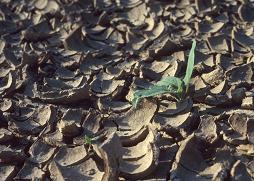 > ENC Master > Climate Encyclopaedia > Food & Climate > more > 1. Past and present > - history
> ENC Master > Climate Encyclopaedia > Food & Climate > more > 1. Past and present > - history
 |
|
|
|
|
Major historical climate events have affected food productionIn extreme cases, climate damage can lead to severe impacts on society. In such cases, additional sources of stress also contribute to the damage. |
|
Potatoes were also the means they relied on to pay the rent to their landlords. Landlords evicted hundreds of thousands of peasants that were forced to emigrate to America and other English-speaking countries. Peasants who ate the rotten produce sickened and entire villages were consumed with cholera and typhus. Many farmers that emigrated in crowded ships died during the journey. The Irish Famine of 1846-50 took as many as one million lives from hunger and disease, and changed the social and cultural structure of Ireland, Britain, and the United States in profound ways.
|
The 1943 Famine in BengalAlmost 100 years after the potato famine in Ireland, another fungus, Helminthosporium oryzae, the cause of brown spot of rice, precipitated another catastrophe in British-ruled Bengal (now part of the Northeast of India and Bangladesh). In 1942-3, the weather conditions were exactly right to encourage an epidemic of the disease. Losses were extreme, often rising to 90% or causing total destruction of the rice crop. Malnutrition and starvation caused the death of over 2 million people. In Bengal in 1942 there were several severe weather events followed by the Japanese occupation of Burma and the subsequent end of rice imports from there that led to a severe shortage of food and the 1943 famine. Many economic factors also contributed to the Bengal famine. The economy was undergoing wartime inflation. Farmers and rural people were at a disadvantage because they made most of their money in the main harvest time, before rice prices began to soar. Since their wages did not reflect the increase in price, they were less able to purchase any food.
|
Recent events in USADuring the last 3 decades crop production losses due to unfavourable or extreme climate events in USA have been significant. But, since they occurred in the United States where the agricultural industry is highly diversified, human suffering was far less than in the previous cases. Extreme events happen in every agricultural region of the country, and occur somewhere in the country almost yearly. Droughts seem to have occurred primarily in the early part of the period, with floods predominating in the 1990s. The most severe weather-related events for agriculture were the drought of 1988 and the flood of 1993.
|
|
Drought of 1988The severe drought of 1988 in the U.S. Midwest started early in the spring and continued throughout most of the summer, accompanied by higher than normal temperatures. It spread to affect the central and south eastern parts of the nation, with consequences to agriculture, water resources, transportation, tourism, and the environment. Crop yields dropped by approximately 37% and required a $3-billion bailout by Congress of affected farmers.
|
|
Crop pests were affected as well, bringing damaging outbreaks of two spotted spider mites (T. urticae) on soybeans throughout the entire Midwest region. The damage occurred during the critical stages. An estimated 3.2 million hectares were sprayed with insecticides to control the mites across the region and losses to Ohio farmers were estimated to be $15 to 20 million. The drought conditions led to decreased flows in the Ohio and lower half of the Mississippi river by the end of May. Mid-summer barge movement was restricted on the major rivers that drain the central U.S. The depth of the rivers near Cairo, Illinois fell to less than 8 feet by mid-June. The reduced flows caused a decrease of 25% in hydropower generation, a decrease in the recreational use of rivers and lakes of 15%, and salt-water intrusion from the Gulf of Mexico 105 miles up the Mississippi River and extending past New Orleans.
|
The Flood of 1993Flooding in the summer months of 1993 affected 16,000 square miles of farmland, with Nebraska, Iowa, and Michigan hardest hit. In July, the flood crest at St. Louis, Missouri broke the previous record. Crops were damaged on over 11 million acres, with losses sustained of over $3 billion. Emergency measures cost over $222 million. Excess wetness presents a particularly severe problem for Iowa’s low-lying soils. The flood of 1993 also provide a strong pulse of nitrates and other nutrients and farming chemicals into the Mississippi River and Gulf of Mexico. |
|
1. Scientific reviewer: Alex de Sherbinin - CIESIN, Columbia University - USA 2. Scientific reviewer: Lily Parshall - Goddard Institute for space studies, Columbia University - USA Educational reviewer: Emilio Sternfeld - Colegio Virgen de Mirasierra - España Last update: 12/05/2004 |



